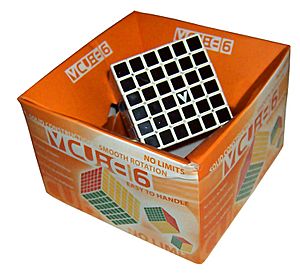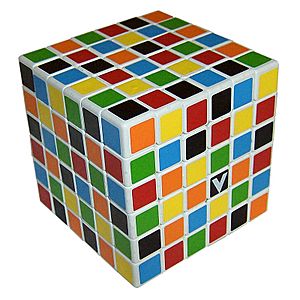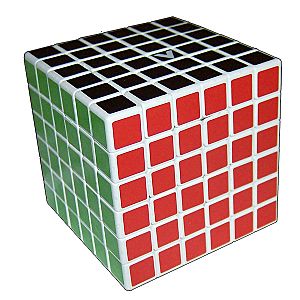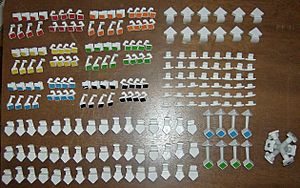V-Cube 6 facts for kids
The V-Cube 6 is a puzzle shaped like a cube, but it's bigger than the classic Rubik's Cube. It has 6 squares on each side, making it a 6x6x6 cube. Panagiotis Verdes from Greece invented the first V-Cube 6 that was sold to many people. His company, Verdes Innovations SA, makes them.
Other companies, especially from China, have also made their own 6x6x6 cubes. Some of these newer cubes work even better than the first ones. Unlike the original Rubik's Cube, the V-Cube 6 doesn't have fixed center pieces. This means the middle squares on each face can move around, just like on a 4x4x4 cube.
When you solve a V-Cube 6, you can use similar tricks to solving a 3x3x3 Rubik's Cube. You just need to remember where the colors should go, since the center pieces don't stay in one spot to help you.
Contents
How the V-Cube 6 Works
The V-Cube 6 puzzle has many small parts on its surface. There are 152 visible pieces. Inside the cube, there are also 60 hidden pieces that move. Six other pieces are fixed to the central frame, which is like a "spider" inside. The V-Cube 7 uses a very similar design, but on that cube, these hidden pieces are visible.
On the V-Cube 6, you'll find different kinds of pieces:
- Center pieces: There are 96 of these, and each shows only one color.
- Edge pieces: There are 48 of these, and each shows two colors.
- Corner pieces: There are 8 of these, and each shows three colors.
Every piece has a special mix of colors. For example, you won't find an edge piece with both red and orange, because red and orange are usually on opposite sides of a solved cube. You can twist the layers of the cube to mix up these pieces. But the colors themselves always stay in the same order relative to each other on a solved cube.
Most V-Cube 6 puzzles are made with white plastic. The colors are set up so that red is opposite orange, blue is opposite green, and yellow is opposite black. One black center piece usually has a "V" logo on it. Verdes also makes a version with black plastic and a white face.
The first V-Cube 6 had flat faces, unlike the rounded V-Cube 7. The pieces on the outside of the V-Cube 6 are a bit wider than the ones in the middle. This design helps make the cube stronger because the corner pieces have a thicker part connecting them to the inside. Later, a V-Cube 6b was made, which has the same rounded shape as the V-Cube 7.
How Many Ways Can You Mix It Up?
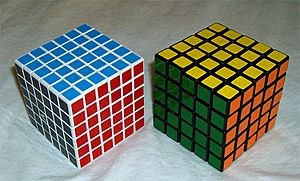
The V-Cube 6 can be mixed up in an incredibly huge number of ways. This number is so big that it's hard to imagine! It's much, much larger than the number of ways a regular 3x3x3 Rubik's Cube can be scrambled.
To give you an idea, the number is about 157 followed by 114 zeros. That's a truly massive number of possible combinations! One of the center pieces has a "V" on it, which makes the number of unique patterns even larger.
Ways to Solve the V-Cube 6
There are many different ways people solve the V-Cube 6. Here are some popular methods:
Reduction Method
The reduction method is very popular, especially among people who solve cubes quickly (called speedcubers). First, you solve all 96 center pieces, making sure the colors are in the correct order on each face. Next, you match up groups of four edge pieces to create solid strips. After these steps, you solve the cube as if it were a giant 3x3x3 cube. Sometimes, you might run into "parity errors" (explained below) that don't happen on a regular 3x3x3 cube.
Yau Method
The Yau method is another common way to solve the V-Cube 6. It's quite similar to the reduction method. The main difference is that some of the steps are done in a different order.
Cage Method
The cage method is different because you solve the edge and corner pieces first. In some versions, you might solve the centers of two opposite faces before doing the edges and corners. The last step is to move the remaining center pieces to their correct faces.
Parity Errors
Parity errors are special situations that can happen on larger cubes like the V-Cube 6, but not on a 3x3x3 Rubik's Cube. These errors need special moves (called algorithms) to fix them. For example, you might have a single group of four edge pieces that looks "flipped," or two groups of edge pieces that are swapped.
World Records
People compete to solve the V-Cube 6 as fast as possible!
The world record for the fastest single solve of a 6x6x6 cube is 1 minute, 9.51 seconds. This amazing time was set by Max Park from the United States on January 25, 2020, at a competition in Houston, Texas.
Max Park also holds the world record for the average of three solves, which is 1 minute, 15.90 seconds. He set this record at the same competition in Houston. His times for those three solves were 1:09.51, 1:23.93, and 1:14.27.
Top 5 Fastest Solvers (Single Solve)
| Name | Fastest solve | Competition |
|---|---|---|
| Max Park | 1:09.51 | Houston Winter 2020 |
| Kevin Hays | 1:14.06 | Vancouver Big Cubes Open 2019 |
| Feliks Zemdegs | 1:18.28 | Warm Up Sydney 2019 |
| Ciarán Beahan | 1:19.70 | Weston-super-Mare Open 2019 |
| Brandon Nunez | 1:21.67 | Princeton Winter 2020 |
Top 5 Fastest Solvers (Average of 3 Solves)
| Name | Fastest average | Competition |
|---|---|---|
| Max Park | 1:15.90 | Houston Winter 2020 |
| Feliks Zemdegs | 1:21.90 | Weston-super-Mare Open 2018 |
| Ciarán Beahan | 1:23.17 | Every Event Éire 2019 |
| Kevin Hays | 1:23.89 | CubingUSA Nationals 2019 |
| Seung Hyuk Nahm (남승혁) | 1:26.96 | China Championship 2018 |
See also
 In Spanish: V-Cube 6 para niños
In Spanish: V-Cube 6 para niños


